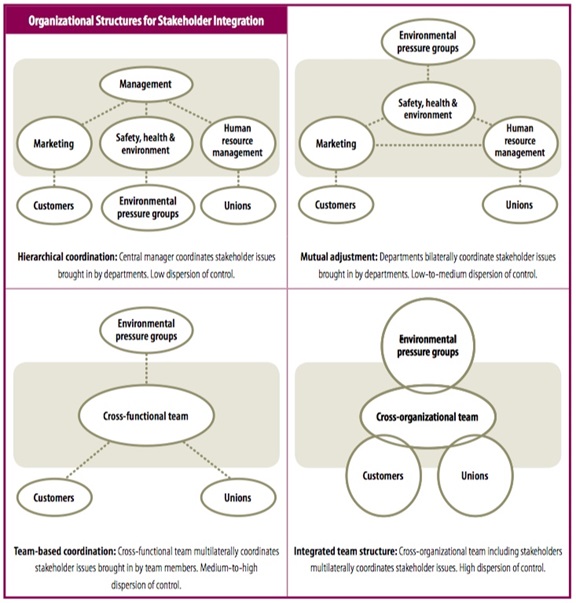
Editors’ note: This article is an abridged and adapted version of “Mechanisms for Stakeholder Integration: Bringing Virtual Stakeholder Dialogue into Organizations,” originally published in Journal of Business Research (Volume 66, Issue 9), in September 2013. Used with permission from Elsevier. This article is from the Nonprofit Quarterly’s spring 2016 edition, “Strategic Nonprofit Management: Frameworks and Scaffolding.”
Organizations build and maintain relationships with their external stakeholders, such as customers, suppliers, governments, nongovernmental organizations, and unions. They engage in continuous communication with multiple stakeholders. Such communication has the character of a dialogue,1 which has led to the emergence of the term stakeholder dialogue.2 Organizations engage in stakeholder dialogues through so-called boundary spanners: organizational members and departments that are directly involved in the dialogue with stakeholders at the interface of the organization and its environment.3
Boundary spanners introduce stakeholder issues into the organization. Stakeholder issues need coordination to ensure that they are distributed to the right organizational members, that boundary spanners act upon promises to stakeholders, and that boundary spanners are prevented from contradicting each other in their communications to stakeholders. Thus, stakeholder integration is the combination of introducing stakeholder issues into the organization and coordinating organizational efforts to deal with these issues.
Stakeholder integration has gained importance with recent technological developments that increased the ease of communication and the interconnectedness among stakeholders. Virtual communication has increased the opportunity to have a dialogue with a great number of stakeholders at the same time. Because of greater ease of communication, more and more diverse stakeholder groups can and will join in stakeholder dialogue, including stakeholders that did not participate in the dialogue before.4 The use of the Internet results not only in more stakeholder issues being voiced (i.e., intensity of the dialogue) but also in more diverse stakeholder issues (i.e., richness of the dialogue). How can organizations deal with the stakeholder issues emerging from virtual stakeholder dialogue?
Despite the growing importance of stakeholder integration in practice, the academic discussion of such integration is underdeveloped. Most researchers treat organizations as black boxes when studying stakeholder integration, resulting in a lack of attention to the internal coordination of the issues emerging from the stakeholder dialogue.5 Even founding fathers of stakeholder theory acknowledge that, while stakeholder theory has a lot to contribute on how to identify stakeholders and their issues, it “does fail to provide an algorithm for day-to-day managerial decision making.”6 (Although debate could exist whether day-to-day managerial decision making should fall within the realm of stakeholder theory, the managerial need for more concrete guidance in this respect is beyond debate.)
The objective of this article is to present some organizational structures to coordinate issues emerging from stakeholder dialogue. While the coordination of stakeholder issues has received scant attention in stakeholder theory, other areas of research are instructive for investigating internal coordination of these issues. Innovation management literature has extensively dealt with the question of how organizations should coordinate various organizational departments involved in product development.7 Bas Hillebrand and Wim Biemans have noted that internal coordination and cooperation with external stakeholders are interrelated, as successful relationships with stakeholders require the firm to internally coordinate the various relationships with these stakeholders.8
The literature suggests a number of mechanisms that organizations can use to coordinate. Two broad categories of coordination mechanisms are distinguished: structures and systems.9 In this article, we will focus on structures that are defined as configurational arrangements for decision making.
Structures as Mechanisms for Stakeholder Integration
The suitability of specific structures in the context of virtual stakeholder dialogue can be determined by the effects that these structures have on organizational identification. Organizational identification refers to the degree to which internal and external stakeholders share beliefs about the central and enduring characteristics of the organization, and reflects a bond between the stakeholders and the organization.10 Once stakeholders strongly identify themselves with the organization, they are more likely to spread positive word-of-mouth, to work in the organization, to financially invest in the organization, and to buy its products or services.11 In this manner, organizational identification by stakeholders leads to increased resources for the organization.12
Sign up for our free newsletters
Subscribe to NPQ's newsletters to have our top stories delivered directly to your inbox.
By signing up, you agree to our privacy policy and terms of use, and to receive messages from NPQ and our partners.
In a virtual context, organizational identification is a particularly important organizational outcome, as such identification represents the “critical glue” that links stakeholders to organizations in the absence of physical meetings.13 Literature on organizational structures suggests that the formal design of roles and administrative mechanisms helps to coordinate activities among actors.14 Structures include bureaucratic control, temporary task forces, matrix structures, and virtual teams,15 and may be characterized by dispersion of control.16 Dispersion of control refers to the degree to which decision making regarding stakeholder issues is distributed throughout the organization or even beyond the boundaries of the organization.17 In a structure with high dispersion of control, many organizational members and external stakeholders participate in decision making. While most studies have focused on organizational structures to coordinate tasks within organizations, these structures can extend beyond the organizational boundary and even include external actors.18 Consequently, this article proposes four organizational structures to enable the coordination of virtual stakeholder issues. The following figure, partly based on Hillebrand and Biemans, shows the four structures ranked from low to high dispersion of control. (Note: The rectangular shape represents the organizational boundary.)

Dispersion of control has a great impact on organizational identification. In general, participation in decision making stimulates sharing organizational norms.19 In virtual stakeholder dialogues, participating stakeholders build a shared understanding of the organization, which leads to organizational identification.20 In a virtual context, active participation leads to increased organizational identification, because stakeholders develop a sense of ownership during the creation of shared meaning.21 When control is dispersed among stakeholders, this sense of ownership among stakeholders is fostered. Therefore, we propose that, in the context of virtual stakeholder dialogue, organizations with structures characterized by high dispersion of control are more likely to have high organizational identification than organizations with structures characterized by low dispersion of control.
We argue that organizations should match their coordination mechanisms (including structures) to the high intensity and richness of virtual stakeholder dialogues. Organizations without proper internal coordination are prone to act incoherently on the issues raised by their stakeholders and likely to face poor organizational identification among their stakeholders. These organizations may not live up to the expectations raised during the dialogue. Organizations with poorly matching coordination mechanisms are likely to be common practice: anecdotal observations suggest that, encouraged by the popular press, consultants, and other organizations in the industry, many organizations decide to engage in virtual stakeholder dialogue. Such organizations are likely to focus on organizing the virtual stakeholder dialogue, for instance, by building web communication platforms. A major challenge for organizations is to prepare internally for virtual stakeholder dialogue, because changing internal structures may prove to be difficult.22 Without suitable coordination mechanisms, engaging in virtual stakeholder dialogue is a superficial attempt to present a favorable appearance. Managerial practices that are only adopted for ceremonial reasons have low effectiveness.23
…
Adopting virtual stakeholder dialogue without suitable coordination mechanisms has detrimental performance consequences. Further research should address the internal coordination aspects of virtual stakeholder dialogue to understand when such dialogue is likely to succeed. A first step in this research is to carefully document the consequences in cases where virtual stakeholder dialogue was not accompanied by matching coordinating mechanisms.
As this article is based on a review of extant literature and as virtual stakeholder dialogue is a nascent domain of study, the inventory of structures presented in this article is unlikely to be exhaustive. Organizations at the forefront of virtual stakeholder dialogue are likely to experiment with new structures in order to deal with the new challenges. Through such experimentation, these organizations will learn to share control with stakeholders in ways that are mutually beneficial.24
Notes
- Michael L. Kent and Maureen Taylor, “Toward a dialogic theory of public relations,” Public Relations Review 28, no. 1 (February 2002): 21–37.
- Jeffrey Unerman and Mark Bennett, “Increased stakeholder dialogue and the internet: towards greater corporate accountability or reinforcing capitalist hegemony?” Accounting, Organizations and Society 29, no. 7 (October 2004): 685–707.
- Ruth Maria Stock, “Interorganizational Teams as Boundary Spanners Between Supplier and Customer Companies,” Journal of the Academy of Marketing Science 34, no. 4 (October 2006): 588–99.
- Robert L. Heath, “New communication technologies: An issues management point of view,” Public Relations Review 24, no. 3 (Autumn 1998): 273–88; and Unerman and Bennett, “Increased stakeholder dialogue and the internet.”
- Paul H. Driessen and Bas Hillebrand, “Integrating Multiple Stakeholder Issues in New Product Development: An Exploration,” Journal of Product Innovation Management 30, no. 2 (March 2013): 364–79.
- Robert A. Phillips, R. Edward Freeman, and Andrew C. Wicks, “What Stakeholder Theory Is Not,” Business Ethics Quarterly 13, no. 4 (October 2003): 479–502.
- Abbie Griffin and John R. Hauser, “Integrating R&D and marketing: A review and analysis of the literature,” Journal of Product Innovation Management 13, no. 3 (May 1996): 191–215.
- Bas Hillebrand and Wim G. Biemans, “Links between Internal and External Cooperation in Product Development: An Exploratory Study,” Journal of Product Innovation Management 21, no. 2 (March 2004): 110–22.
- Jody Hoffer Gittell, “Coordinating Mechanisms in Care Provider Groups: Relational Coordination as a Mediator and Input Uncertainty as a Moderator of Performance Effects,” Management Science 48, no. 11 (November 2002): 1408–26; Griffin and Hauser, “Integrating R&D and marketing”; and Andrew H. Van De Ven, Andre L. Delbecq, and Richard Koenig Jr., “Determinants of Coordination Modes within Organizations,” American Sociological Review 41, no. 2 (April 1976): 322–38.
- B. Bhattacharya and Kimberly D. Elsbach, “Us Versus Them: The Roles of Organizational Identification and Disidentification in Social Marketing Initiatives,” Journal of Public Policy & Marketing 21, no. 1 (Spring 2002): 26–36; and Isabelle Maignan and O. C. Ferrell, “Corporate Social Responsibility and Marketing: An Integrative Framework,” Journal of the Academy of Marketing Science 32, no. 1 (December 2004): 3–19.
- Michael Ahearne, C. B. Bhattacharya, and Thomas Gruen, “Antecedents and Consequences of Customer– Company Identification: Expanding the Role of Relationship Marketing,” Journal of Applied Psychology 90, no. 3 (May 2005): 574–85.
- Maignan and Ferrell, “Corporate Social Responsibility and Marketing.”
- Batia M. Wiesenfeld, Sumita Raghuram, and Raghu Garud, “Communication Patterns as Determinants of Organizational Identification in a Virtual Organization,” Organization Science 10, no. 6 (November/December 1999): 777–90.
- Henry Mintzberg, The Structuring of Organizations (Englewood Cliffs, NJ: Prentice-Hall, 1979).
- See Tom Burns and G. M. Stalker, The Management of Innovation (London: Tavistock Publications, 1961); see also Eric M. Olson, Orville C. Walker Jr., and Robert W. Ruekert, “Organizing for Effective New Product Development: The Moderating Role of Product Innovativeness,” Journal of Marketing 59, no. 1 (January 1995), 48–62.
- Griffin and Hauser, “Integrating R&D and marketing.”
- See also Arnold S. Tannenbaum, Control in Organizations (New York: McGraw-Hill, 1968).
- Bas Hillebrand and Wim G. Biemans, “The relationship between internal and external cooperation: literature review and propositions,” Journal of Business Research 56, no. 9 (September 2003): 735–43.
- Arnold S. Tannenbaum, “Control in Organizations: Individual Adjustment and Organizational Performance,” Administrative Science Quarterly 7, no. 2 (September 1962): 236–57.
- Nicola Stokburger-Sauer, “Brand community: Drivers and outcomes,” Psychology & Marketing 27, no. 4 (April 2010): 347–68.
- Wiesenfeld, Raghuram, and Garud, “Communication Patterns as Determinants of Organizational Identification in a Virtual Organization.”
- Michael T. Hannan and John Freeman, “Structural Inertia and Organizational Change,” American Sociological Review 49, no. 2 (April 1984): 149–64.
- Tatiana Kostova and Kendall Roth, “Adoption of an Organizational Practice by Subsidiaries of Multinational Corporations: Institutional and Relational Effects,” Academy of Management Journal 45, no. 1 (January 2002): 215–33.
- Bas Hillebrand, Paul H. Driessen, and Oliver Koll, “Stakeholder marketing: theoretical foundations and required capabilities,” Journal of the Academy of Marketing Science 43, no. 4 (July 2015): 411–28.











